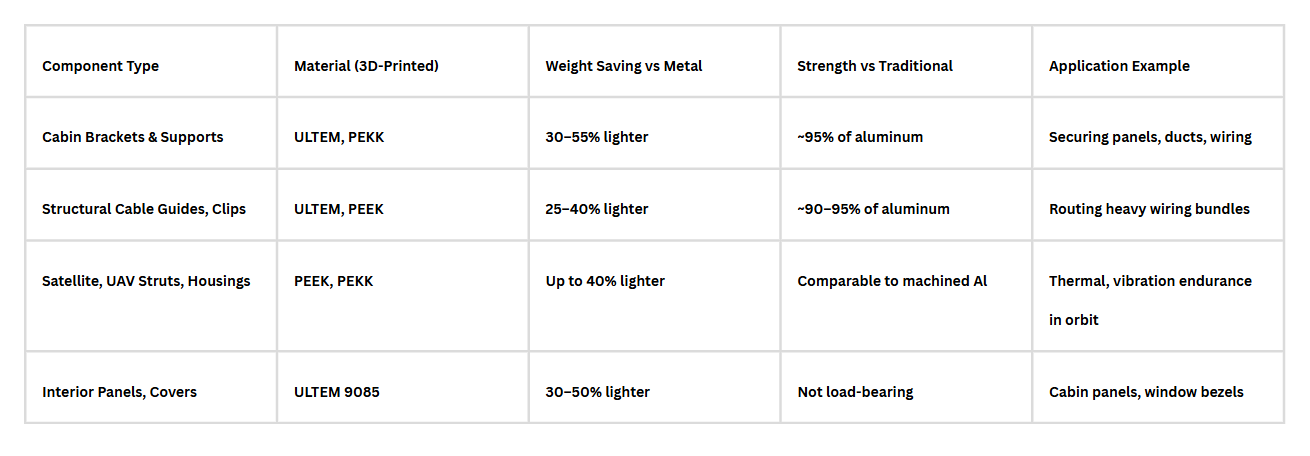Is 3D-Printed Plastic Good Enough for Aerospace Applications?


At first glance, the answer might seem obvious: they shouldn’t be good enough, right? After all, 3D-printed plastics suffer from well-known weaknesses. Unlike metals or composites, printed plastics are prone to anisotropy; they're much weaker along the vertical (Z) build axis than across the horizontal layers [1]. The printing process can leave behind microscopic voids and rough surfaces, which reduce fatigue resistance. Early parts often showed warping, poor repeatability, and inconsistent strength, making them unsuitable for anything beyond tray tables, ducts, or cosmetic covers.
But advances in smart design strategies and new high-performance materials have flipped the script. Engineering-grade polymers like ULTEM™ 9085, PEEK, and PEKK not only meet aerospace flame, smoke, and toxicity (FST) standards [2][3][4] but also deliver impressive strength-to-weight ratios. Combined with design optimization, they’ve enabled the production of load-bearing components that were once thought impossible in plastics. For example, cabin brackets and supports made from ULTEM or PEKK are now replacing aluminum parts, cutting weight by 30–55% while still meeting the same load requirements [5]. Similarly, structural cable guides and clips are being printed to manage heavy wiring bundles, with parts showing strength within 90–95% of aluminum equivalents but at much lower density, leading to substantial fuel savings [6]. Beyond aircraft interiors, satellites and UAVs are increasingly using lightweight PEEK struts and housings, which are up to 40% lighter than machined aluminum yet capable of withstanding thermal swings from –150°C to +150°C and continuous vibration loads in orbit [7].


Crucially, regulatory authorities have given 3D-printed plastics a green light in many cases. Both FAA and EASA have approved flight-ready ULTEM and PEEK parts for use in cabins, ducts, and even semi-structural brackets [8]. Airlines like Lufthansa Technik use printed plastic parts for repairs and retrofits, avoiding long lead times for spares [9]. Airbus and Boeing routinely fly with certified 3D-printed cabin and support components, proving that these materials can meet strict aerospace safety standards [5][6].
At the production level, the benefits are even broader. 3D printing allows rapid prototyping, on-demand manufacturing, and retrofitting of custom cabin layouts without expensive tooling [10]. Airlines can replace or redesign a part in weeks instead of months, while suppliers save on inventory costs. For older aircraft, where spares are scarce, 3D printing provides a lifeline manufacturing discontinued parts without restarting an entire production line [9].
Looking ahead, the future of 3D printing in aerospace plastics is full of promise. As materials improve, inspection methods mature, and certification processes become more streamlined, we can expect even more structural and non-structural alike to take flight. While metals and composites will continue to dominate primary load-bearing roles, plastics are carving out a proven, trusted niche that will only grow stronger in the years to come.
References
Datasheets (Materials):
Stratasys – ULTEM™ 9085 Material Data Sheet
Victrex –PEEK Aerospace Datasheet
Arkema Kepstan® – PEKK Aerospace Datasheet
Industry Applications & Certifications:
4. SABIC – ULTEM Resin Aerospace Datasheet
5. Airbus – Certified 3D-printed ULTEM cabin brackets and supports
6. Boeing – Integration of ULTEM 9085 parts in aircraft interiors
7. NASA – Testing of 3D-printed thermoplastics and composites for spaceflight
8. EASA – Certification Memo on Additive Manufacturing
9. Lufthansa Technik – Additive Manufacturing Services
10. GE Aviation – FAA-certified additively manufactured components
Quick Comparison
Contact
Discover how we turn ideas into reality.
Services
contact@a2solution.tech
+91 84849 60416
© 2025. All rights reserved.
Austin Manuel
2D Drafting
3D Modeling
Plastic Injection Mould Design
FEA, CFD & Mould Flow Analysis
3D Printing
SPM Design
